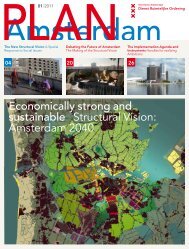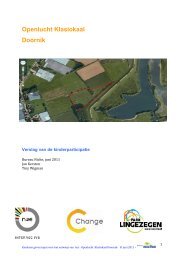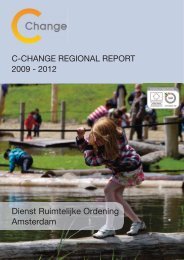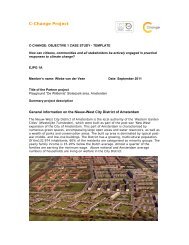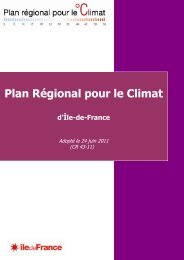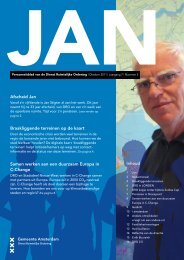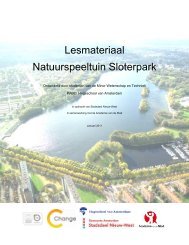Saarland Regional Report - C-Change
Saarland Regional Report - C-Change
Saarland Regional Report - C-Change
Create successful ePaper yourself
Turn your PDF publications into a flip-book with our unique Google optimized e-Paper software.
C-CHANGE REGIONAL REPORT<br />
2009 - 2012<br />
<strong>Saarland</strong> Spatial Planning Department<br />
Ministry of Interior and Sport
Climate change will lead to lasting spatial impacts. We are hence obliged to increasingly apply preventive mitigation<br />
measures, whilst turning our attention to adapting to those consequences of advancing climate change which are<br />
already foreseeable today. An increasing number of hot and dry periods, heavy rains and floods corroborate the need<br />
for action, also in <strong>Saarland</strong>. The EU-project C-<strong>Change</strong> provided the <strong>Saarland</strong> partners with an opportunity for reviewing<br />
current planning and development programmes on a state, regional and municipal level in order to improve the<br />
integration of climate mitigation and adaptation measures (Action 20). Besides these planning approaches, a climate<br />
path (Action 14 and Investment 5) has been realised aiming at sensitizing people to climate change and its<br />
repercussions.<br />
<strong>Saarland</strong> regional partner is the Spatial Planning Department within the <strong>Saarland</strong> Ministry for Interior and Sport. Other<br />
project partners are the Saarbrücken Authority for Green Spaces, Forestry and Agriculture and the <strong>Saarland</strong> Department<br />
for Sustainable Development within the <strong>Saarland</strong> Ministry of the Environment and Consumer Protection. The project is<br />
managed by agl | Hartz • Saad • Wendl.<br />
<strong>Saarland</strong> Climate proof Spatial<br />
Planning<br />
1. Project Description<br />
In the <strong>Saarland</strong>, current plans and development<br />
programmes on a state-wide, regional and urban level<br />
are being examined in terms of how they can<br />
contribute to mitigation and adaptation strategies. Within<br />
the framework of the C-<strong>Change</strong> project the <strong>Saarland</strong><br />
State Development Plan, the action programme for the<br />
“Northern Landscape of Industrial Culture” as well as<br />
the Saarbrücken Open Space Development Programme<br />
stood in the centre of consideration:<br />
• The <strong>Saarland</strong> State Development Plan coordinates<br />
the various space utilisation demands of modern society.<br />
It is presently being redrafted in order to address current<br />
challenges entailed by changes in the economic<br />
structure and demographics, as well as the energyrelated<br />
reorientation. With the C-<strong>Change</strong> project the<br />
spatial planning avails itself of the opportunity for<br />
elaborating conceptual proposals for handling climate<br />
change from a spatial planning perspective as part<br />
of this re-draft.<br />
• For the Northern Landscape of Industrial Culture<br />
(NLIC) – a part of the Saar agglomeration characterised<br />
by the decline of the steel industry and coal mining and<br />
by a heavily shrinking population – an intermunicipal<br />
action programme has been elaborated jointly with the<br />
local stakeholders. This pilot project "Landscape and<br />
Climate <strong>Change</strong>" demonstrates by way of example,<br />
which concrete measures can be implemented on a<br />
sub-regional or local level for mitigation and adaptation.<br />
1
• The state capital Saarbrücken is one of nine model<br />
cities taking part in the German Experimental Housing<br />
and Urban Development programme on urban strategies<br />
tackling the impacts of climate change - www.stadtund-klimawandel.de<br />
- ExWoSt. Starting from the<br />
Saarbrücken Open Space Development Programme<br />
(OSDP), the climatic relevance of open spaces is being<br />
examined with the aim of demonstrating how open<br />
spaces can help cities improve their adaptation to the<br />
consequences of climate change. The fundamentals and<br />
strategies for this have been developed as part of the<br />
C-<strong>Change</strong> project. Building on this, a broad involvement<br />
process has been started in order to sensitise the<br />
population for this subject and jointly explore definitive<br />
action options.<br />
All regional projects have been presented to a broader<br />
audience and local stakeholders at the <strong>Regional</strong> Park<br />
Forum. It took place on the 28th March 2012 in<br />
Saarbrücken and was dedicated to the topic of climate<br />
change.<br />
2. Key Outputs, Activities and<br />
Achievements<br />
The C-<strong>Change</strong> project provided an excellent opportunity<br />
to elaborate conceptual proposals for adequately<br />
addressing adaptation strategies in the redraft of the<br />
formal and binding <strong>Saarland</strong> State Development Plan.<br />
Several workshops and bilateral coordination meetings<br />
with the various sector departments on state level<br />
ensured that sectoral as well as regionally specific<br />
requirements found intensive consideration. The main<br />
results were compiled within the final reports:<br />
• The first step was made by evaluating regional climate<br />
models to track climate change and its impact. This<br />
leads to a broader understanding of the complex and<br />
spatially relevant climate change consequences on<br />
regional level. The results indicate that summertime heat<br />
stress in the <strong>Saarland</strong> will show an above average<br />
increase in comparison with Germany as a whole.<br />
Declining summer precipitations in combination with<br />
rising summer temperatures may furthermore lead to<br />
more frequent and/or longer dry periods. As heavy<br />
precipitations are on the increase nationwide, the<br />
frequency of flooding events and risk of soil erosion may<br />
also increase in connection with rising precipitation<br />
volumes in winter.<br />
• The second step focused on the analyses of the<br />
vulnerability of land uses and structures regarding<br />
thermal stress, dry periods and flood risks. The results<br />
show that urban areas and the soil, in particular, show<br />
a high vulnerability, but also agriculture and the nature<br />
conservation areas. It became clear that the cold air<br />
supply of the densely settled areas is of key importance.<br />
For this reason C-<strong>Change</strong> also included an analysis of<br />
climate-active areas and cold air outflow routes<br />
throughout the <strong>Saarland</strong>, which will need to be further<br />
concretised in both the state development planning and<br />
the local planning.<br />
• Exploring adaptation capacities is a major step when<br />
it comes to concrete planning and realisation of<br />
measures. Adaptation potentials regarding the heat<br />
stress in urban environments are for example provided<br />
by the development of a system of interconnected urban<br />
green spaces, an optimisation of air exchange processes<br />
between the city centre and surrounding areas, and in<br />
the linkage of nearby recreational spaces with a bioclimatic<br />
and air hygiene welfare function. Adaptation<br />
potentials regarding an increased number of flooding<br />
events are most of all provided in the fields of land use<br />
and building precautions and risk management, and by<br />
an active promotion of risk awareness.<br />
• Considering the binding character of the <strong>Saarland</strong><br />
State Development Plan, it has been necessary to<br />
provide suggestions for integrating the topic of climate<br />
change and adaptation into the formal state planning,<br />
and in particular for designing and further developing the<br />
formal planning tools of state development planning. The<br />
investigation proved e.g. the importance to determinate<br />
green corridors especially throughout the Saar<br />
agglomeration. The results will be directly included<br />
in the planning processing to follow.<br />
Sensitivity of municipalities regarding heat stress<br />
(source: HHP / JRU 2011)<br />
2
C-<strong>Change</strong> also involved the implementation of a<br />
“Landscape and Climate <strong>Change</strong>“ pilot project by the<br />
Spatial Planning Department in the Northern Landscape<br />
of Industrial Culture (NLIC). Two joint workshops with<br />
local actors led to a set of adaptation as well as<br />
mitigation measures for the sub-region. The measures<br />
focus on nature and landscape, not least of all because<br />
NLIC is the location of Germany’s very first federal largescale<br />
nature conservation project to be implemented in<br />
an urban-industrial area. Of particular importance here<br />
are the involvement of local potentials and activities,<br />
ensuring coordination with the large-scale nature<br />
conservation project, and the development of initial ideas<br />
for projects and measures. The project ended up with<br />
an intermunicipal action programme.<br />
Within the C-<strong>Change</strong> project Saarbrücken puts an<br />
emphasis on the climatic relevance of open spaces.<br />
Open spaces are of particular importance for the urban<br />
climate and more accessible for adaptation measures<br />
than urban architectural structures. A starting point<br />
is provided by the Saarbrücken Open Space<br />
Development Programme (OSDP), which has<br />
established itself as a successful instrument of open<br />
space policy since 2008. However, the spatial impacts<br />
of climate change have not been integrated so far. On<br />
this basis Saarbrücken participates in the German<br />
Federal Institute for Research on Building, Urban Affairs<br />
and Spatial Development (BBSR) research programme<br />
“Experimental Housing and Urban Development“<br />
(ExWoSt) dealing with “Urban Strategies Towards<br />
Climate <strong>Change</strong>”. The programme serves to examine<br />
how cities across the nation can prepare for the<br />
consequences of climate change. Saarbrücken is one of<br />
nine model cities. The C-<strong>Change</strong> project provided a first<br />
stimulus for offensively integrating mitigation and in<br />
particular climate adaptation strategies in the Open<br />
Space Development Programme, but also important<br />
stimuli for an urban development which adequately<br />
addresses climate change.<br />
There were three main aspects pursued in the context of<br />
the OSDP:<br />
• Building on a vulnerability analysis for the overall city<br />
and a well-founded assessment of the climatic relevance<br />
of various types of open space, adaptation strategies<br />
and options have been elaborated for the planning of<br />
urban open spaces. That was the contribution of<br />
C-<strong>Change</strong>. On this basis, concrete measures have been<br />
developed in two urban districts as part of the ExWoSt<br />
pilot project.<br />
TITLE: Vulnerability of settlement areas in Saarbrücken<br />
regarding heat stress (source: agl 2012)<br />
3
The district forum on the urban heat island effect in Alt-Saarbrücken (source: agl 2012)<br />
• Where dealing with heavy rain is concerned, the<br />
district of Rußhütte was selected, where flooding events<br />
with partly catastrophic repercussions for the residents<br />
have already occurred in the past. Two citizens‘ events<br />
have already taken place here. Definitive adaptation<br />
measures for private and public spaces as well as<br />
necessary improvements in the risk management were<br />
discussed with local residents and those responsible in<br />
the municipal authorities and waste disposal companies,<br />
the Meteorological Service and the fire brigade. The<br />
dialogue continues, and first measures have already<br />
been implemented.<br />
• The adaptation to increasing thermal stress has been<br />
elaborated using the district of Alt-Saarbrücken as an<br />
example. This district features a broad range of areas,<br />
from low to high stress, as well as a heterogeneous<br />
structure of open spaces and settlements. Both public<br />
and private open spaces provide starting points for<br />
adaptation measures. Two large-scale urban<br />
development projects where the consequences of<br />
climate change should find consideration in the planning<br />
are located within the district: the “New Urban Centre<br />
by the River” and the new residential area of<br />
Franzenbrunnen. The project has been actively<br />
supported by a committed citizens‘ district forum. Within<br />
the ExWoSt programme innovative forms of participation<br />
have been explored: a guided city walk through<br />
Alt-Saarbrücken put on stage the impacts of increasing<br />
thermal load.<br />
Important institutions have been involved in the overall<br />
process right from the start: the Spatial Planning<br />
Department of the <strong>Saarland</strong>, the regional planning<br />
association of Saarbrücken, various municipal authorities<br />
and companies, but also private protagonists such as<br />
RAG Montan Immobilien GmbH. The focus was on<br />
exploring their action potentials for adaptation measures,<br />
and hence initiating a broad governance process for<br />
mitigation and adaptation.<br />
The guided city walk through Alt-Saarbrücken put on stage the impacts of increasing thermal load<br />
(source: Dirk Michler 2012)<br />
4
3. Objectives Addressed<br />
The main questions addresed were:<br />
• How can regions and cities adapt to the<br />
consequences of climate change<br />
• What role do open spaces play when it comes to<br />
adaptation<br />
• What can be done in the urban and regional planning<br />
to further mitigation and adaptation measures<br />
• How can we interlink the different planning levels in<br />
order to coordinate adaptation and mitigation strategies<br />
• Is it necessary to readjust existing planning tools and<br />
processes<br />
• How can local stakeholders be actively involved into<br />
current planning processes as well as in the actual<br />
implementation of measures<br />
4. Results and Conclusions<br />
In the <strong>Saarland</strong>, C-<strong>Change</strong> involves the pursuit of<br />
integrated spatial planning approaches designed to<br />
incorporate the cross-sectional theme of climate change<br />
in various levels of spatial planning – from the state<br />
planning via the activities in the regional planning<br />
association of Saarbrücken and inter-municipal action<br />
programmes through to the planning of urban open<br />
spaces – and network them intensively. Climate change<br />
is hence not, as is so often the case, processed<br />
independently of current planning processes, but instead<br />
embedded in them. Only this way can possible target<br />
conflicts between, for example, the expansion of<br />
regenerative energy and climate adaptation measures,<br />
or also between the concepts of compact vs. climateadapted<br />
city.<br />
The C-<strong>Change</strong> project in Saarbrücken but also the<br />
results at state level furthermore demonstrate the central<br />
importance of open spaces for climate change-proof<br />
urban development, and elaborate concrete proposals<br />
for securing and/or upgrading climate-relevant open<br />
spaces. The results of Saarbrücken within the framework<br />
of the ExWoSt research programme are systematised<br />
and can also be applied in other cities.<br />
The C-<strong>Change</strong> projects additionally show which basic<br />
data are meaningful and required for urban strategies<br />
addressing climate change and how necessary it is to<br />
integrate new approaches such as vulnerability analyses<br />
into spatial planning procedures. The readjustment of<br />
existing planning tools and processes is necessary. That<br />
means existing spatial planning procedures need to be<br />
adjusted correspondingly to the challenges related to<br />
climate change. The answers for the design of the<br />
planning tools are meant to provide models for an<br />
effective approach to the subject of climate change,<br />
whilst bridging the gap to the actual implementation<br />
of measures.<br />
The dialogue at local level proved how important<br />
communication and participation strategies are as the<br />
necessity of adaptation is hardly perceived by most local<br />
actors – in contrast to the importance of climate<br />
protection and the development of renewable energies.<br />
Within the context of the city of Saarbrücken’s open<br />
space project, broad citizens‘ involvement – regarding<br />
„heavy rains“ in the sense of a risk governance<br />
approach, and regarding thermal stress as a broadly<br />
designed discussion process – showed how important<br />
tailor-made concepts of participation processes are.<br />
5<br />
<strong>Regional</strong> Park Forum 2012 on Climate <strong>Change</strong><br />
(source: Dirk Michler)
Climate <strong>Change</strong> Urban Landscape<br />
Labs: The Climate Path<br />
1. Project Description<br />
At the beginning of the search for new and creative ways<br />
to foster the understanding of climate change and its<br />
impacts the project partnership agreed on the concept<br />
of a Climate Path. It was decided to cooperate with the<br />
<strong>Saarland</strong> art college HBK in Saarbrücken in order to<br />
involve young people and get innovative ideas how to<br />
realise the project.<br />
In 2010, an excursion had led the Tour d’énergie project<br />
group as well as a number of students from the <strong>Saarland</strong><br />
art college HBK in Saarbrücken, and the C-<strong>Change</strong><br />
project group “Climate Route Offenbach“ to the Climate<br />
House in Bremerhaven. This visit brought first<br />
impressions and initiated the exchange between the two<br />
projects. In a Climate <strong>Change</strong> Urban Landscape Lab<br />
seminar at the HBK college the group of students then<br />
brainstormed possible designs for individual stations<br />
within the climate path. They provided inspirations and<br />
ideas for addressing people in a targeted manner and<br />
awoke their interest over and beyond handed-down<br />
methods. Eleven presentations highlighted diverse<br />
aspects of the subject matter. The installations<br />
developed by the students appealed to the senses, and<br />
some of them later came to be included in the concept<br />
for the climate path in a modified form.<br />
Of initial importance after the brainstorming stage was<br />
the development of a clear profile for the climate path.<br />
To this end the area in question, the Northern Landscape<br />
of Industrial Culture, was once more subjected to an<br />
intensive analysis. The <strong>Saarland</strong> understands itself as a<br />
mining and industrial location, and traditionally also as an<br />
energy-generating region. In the Northern Landscape of<br />
Industrial Culture this tradition is still kept alive by the<br />
industrial and mining heritage. At the same time the<br />
development of regenerative energies is driven forward,<br />
also in the former mining locations. In addition to this,<br />
wood plays a central part in the richly forested <strong>Saarland</strong><br />
as the oldest source of energy. Climate change and the<br />
energy turnaround are indivisibly linked: only if the<br />
development of regenerative energies is successful can<br />
mitigation be effectively implemented. The climate path<br />
addresses this subject, which is also the reason why it<br />
was given the name Tour d’énergie.<br />
The climate change library (source: Dirk Michler)<br />
6
After the concept of the climate path was finalised and<br />
introduced to the local stakeholders concerned, as well<br />
as the special purpose association of the large-scale<br />
nature conservation project, its stations were being set<br />
up, including the attendant signage. In August 2011 the<br />
site was toured by the <strong>Saarland</strong>’s Minister for the<br />
Environment, Energy and Transport, Ms Simone Peter, as<br />
well as representatives of the Neunkirchen district,<br />
the municipalities concerned, and the special purpose<br />
association. The Climate Path was completed in<br />
February 2012 and handed over to the public at the 27th<br />
March 2012 in the context of the <strong>Saarland</strong> <strong>Regional</strong> Park<br />
Forum dedicated to the outcomes of the C-<strong>Change</strong><br />
project.<br />
2. Key Outputs, Activities and<br />
Achievements<br />
The Climate Path is designed as a “Tour d’énergie” to<br />
be experienced as a bicycle tour, preferable by electric<br />
bicycles. It connects the former mining locations of<br />
Reden and Göttelborn and thus two of the four<br />
landscape labs of the large-scale nature conservation<br />
project within the Northern Landscape of Industrial<br />
a mountain, a forest and a sun section. While the<br />
mountain and sun sections address the subjects of<br />
energy generation and regenerative energy, the forest<br />
section is dedicated to the forest and its function for<br />
mitigation, for example as a CO2-reducer, and for<br />
adaptation.<br />
3. Objectives Addressed<br />
The main questions addressed were:<br />
• How can we communicate the very complex topic<br />
of climate change in an appropriate manner addressing<br />
different target groups<br />
• How can we activate and motivate citizens to<br />
contribute to mitigation and adaptation measures<br />
4. Results and Conclusions<br />
C-<strong>Change</strong> is about a sea change and thus about raising<br />
awareness using strategies and projects to help climate<br />
change being recognised as a key challenge to all of us.<br />
Therefore, projects should very directly address the<br />
public, in order to raise people‘s awareness of the<br />
consequences of climate change, and to stimulate them<br />
into taking action themselves. The message is: Everyone<br />
can contribute! In this sense, the Climate Path served to<br />
try out new forms of communication designed to make<br />
the topic of „climate change“ accessible to a broader<br />
public in an event-orientated manner without<br />
„moralising“.<br />
Opening of the <strong>Saarland</strong> Climate Path in March 2012<br />
(source: Dirk Michler)<br />
At various stations visitors can either directly download<br />
information with their cellphones via QR code linked to<br />
the climate path website, or look up the messages in the<br />
printed brochure. The interventions as well as visual and<br />
textual treatment of the subject matter have been<br />
designed in a manner ensuring their suitability also<br />
for children and adolescents from the age of 13.<br />
Lessons learnt mainly refer to the involvement of local<br />
actors and young people into the planning process in<br />
terms of a “laboratory” as well as to the necessity to<br />
communicate climate change related issues in a new<br />
way. Much in keeping with C-<strong>Change</strong>, visitors of the<br />
Climate Path can experience various aspects of climate<br />
change from a very unusual perspective. This helps to<br />
test new forms of communication for presenting a highly<br />
complex subject to the population in an exciting and<br />
event-filled manner.<br />
7
The Organisational Learning<br />
C-<strong>Change</strong> initiated a broad governance process in the<br />
<strong>Saarland</strong> and in Saarbrücken that brought important<br />
stakeholders on board and involved them in a dialogue<br />
on mitigation and adaptation strategies in spatial<br />
development. The exchange improved the understanding<br />
of climate change and its impacts. The joint work helped<br />
to tap into the opportunities to cope with the challenges<br />
of climate change provided by existing spatial planning<br />
tools.<br />
The <strong>Saarland</strong> projects were selected as case studies for<br />
the work of the Expert Joint Planning Groups. They<br />
therefore decisively contributed to the processing of the<br />
C-<strong>Change</strong> themes, whilst the exchange with the experts<br />
from partner regions helped to further qualify the regional<br />
projects. On the Länder level, the results of the C-<br />
<strong>Change</strong> project will be included in the formal and binding<br />
<strong>Saarland</strong> State Development Plan. The action<br />
programme is to be implemented in the Northern<br />
Landscape of Industrial Culture via the municipalities,<br />
the forestry department as well as the large scale nature<br />
conservation project. In the city of Saarbrücken the<br />
results will be integrated in the Open Space Development<br />
Programme as well as the urban (district) development<br />
programmes. The C-<strong>Change</strong> project’s direct link with<br />
existing plans and processes helps ensure an effective<br />
integration, and hence a positive impact on public<br />
policies with regard to mitigation and adaptation<br />
strategies.<br />
C-<strong>Change</strong> Products in <strong>Saarland</strong><br />
• Interim <strong>Report</strong> on the <strong>Saarland</strong> C-<strong>Change</strong> projects<br />
• Final <strong>Report</strong> on the <strong>Saarland</strong> C-<strong>Change</strong> projects<br />
• <strong>Report</strong> on the analysis of cold air production areas<br />
and cold air streams throughout the <strong>Saarland</strong>, University<br />
of the <strong>Saarland</strong> University<br />
• <strong>Report</strong>s on conceptual proposals for adaptation and<br />
mitigation strategies within the framework of the<br />
<strong>Saarland</strong> State Development Plan (2 reports and maps)<br />
• <strong>Report</strong> on the „Landscape and Climate <strong>Change</strong>“ pilot<br />
project within the Northern Landscape of Industrial<br />
Culture<br />
• <strong>Report</strong> on the <strong>Regional</strong> Park Forum<br />
• <strong>Report</strong> on the integration of climate change and<br />
adaptation strategies into the Saarbrücken Open Space<br />
Development Programme<br />
• Stations, signage and signboard of the Climate Path,<br />
the Tour d’énergie<br />
• Booklet about the Climate Path, the Tour d’énergie<br />
• Map of the Climate Path, the Tour d’énergie<br />
• Website on the Climate Path, the Tour d’énergie<br />
aus<br />
Richtung<br />
Landsweiler<br />
Richtung<br />
Bahnhof<br />
Alexander-von-Humboldt-Str.<br />
100 m 250 m 500 m 750 m 1 km 1,5 km<br />
2 km<br />
aus Richtung<br />
Bildstock<br />
landsweiler-reden<br />
göttelborn<br />
Map of the Climate Path, the Tour d’énergie<br />
8





